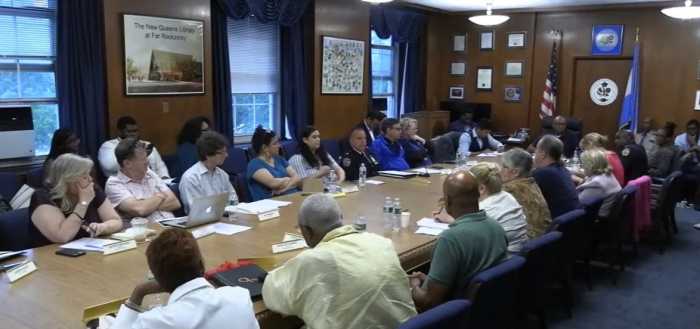
BY SEAN EGAN | Throughout his decades-long career, Nick Cave has made a point of pushing himself forward musically and artistically. With his main band, Nick Cave and the Bad Seeds, Cave’s albums incorporate loud, heavy rock, piano-based ballads, electronic and looping experiments, acoustic instrumentation and orchestral arrangements — to say nothing of the raw post-punk of his first band, the Birthday Party, the noisy thrash of side project Grinderman and his moody, ambient film soundtracks. The one consistent thing throughout these stylistically disparate projects is the man himself, and his distinctive authorial (and singing) voice — dark, humorous, powerful, verbose and a little profound, and willing to tackle the headiest of themes and existential questions, or cheekily subvert rock ‘n roll clichés.
It’s fitting then, that “20,000 Days on Earth,” the new film which finds Cave as its subject, refuses to be categorized easily. Not quite a documentary and definitely not a concert film (though it features some extraordinary performance footage), it’s perhaps best described as a non-fiction film with a fictional framing device. While initially being hired to film promo footage during the recording of the Seeds’ 2013 album, “Push the Sky Away,” directors Iain Forsyth and Jane Pollard decided to expand the footage into a feature. Following Cave as he drifts through his fictional, titular 20,000th day, the film mixes the off-the-cuff and real with the manufactured in ways that provide a unique, subdued portrait of an artist who deserves a film as distinct as his voice.
‘20,000 Days’ is as versatile and ambitious as its topic, Nick Cave
One of the ways the filmmakers accomplish this is by staging situations to provoke certain reactions from Cave and company, and allowing the participants to react via unscripted conversation. Early scenes, for instance, show Cave speaking with a psychiatrist and opening up about his youth, his relationship with his father, and how the passage of time affects his work. Later on, he’s allowed to pick through things from the Nick Cave Collection (a collection of his papers, writing and photographs), causing him to reminisce about the early days of his career and meet up with right-hand Bad Seed Warren Ellis for lunch — during which they have a conversation about the best gigs they’ve ever attended. The most intriguing of these real/fake situations are the hallucinatory sequences which find Cave driving with various figures from his past. Putting Cave in the car alone with Kylie Minogue, actor Ray Winstone, and ex-Bad Seed Blixa Bargeld sparks conversations that muse on the trappings of fame, identity, the nature of creative collaboration. It’s an interesting way to structure the film, which often yields quietly revelatory responses.
Perhaps the most interesting and revealing information comes from the obviously staged moments, when Cave (who, along with the directors, co-wrote the film) is left alone to wax philosophic. Periodically, Cave’s rich baritone intones internal monologues over picturesque images of perennially rainy Brighton, England (the cinematography is top-notch, awash in rich navy blues, greens, grays, and beige). In his characteristically vivid language, he speaks on his creative process, offering candid insight into how he approaches writing music and lyrics — comparing himself to a cannibal, consuming and regurgitating life experiences into lyrics, and songs to wild beasts that need to be captured and tamed. His thoughts on performance and his rock star persona are similarly enlightening — he talks eloquently about how he lives for performing, the transformative experience of being on stage and connecting with people.
FILM | 20,000 DAYS ON EARTH
Written by Iain Forsyth
& Jane Pollared and Nick Cave
Directed by Iain Forsyth & Jane Pollard, 2014
Runtime: 97 min.
Through Sept. 30
At Film Forum
209 W. Houston St., W. of Sixth Ave.
Screenings at 12:30, 2:40, 4:50, 7:00 & 9:30 p.m.
Tickets: $13
Film Forum Members: $7.50
Tickets & info: filmforum.org
It’s no surprise then that the film, and Cave himself, are never more hypnotizing than when he’s playing with the Bad Seeds. One scene, filmed during the recording of “Push the Sky Away” captures Cave at his most musically introspective — hunched over his piano, leading the band in a beautiful rendition the rambling epic “Higgs Boson Blues.” Outside the studio, the band viciously tears through “Stagger Lee” (a profane, grimy rocker from 1996’s “Murder Ballads”) to a crowd of hyped-up fans — the soft-spoken and mild-mannered Cave of the preceding film becoming the swaggering, fiery rock icon fans see him as.
The climax of the film comes as Cave the Bad Seeds take the stage of the Sydney Opera House, in their home country of Australia. Joined by an orchestra and a children’s choir, they launch into a transcendent performance of “Push the Sky Away” standout “Jubilee Street.” The band works itself up to an impressive crescendo, and footage of Cave performing onstage over the decades is interspersed (in the last of a few frenetically edited montages) — as Cave belts “I’m transforming, I’m vibrating…Look at me now.” It’s a dynamic, almost overwhelming, way of showing both how much and how little time has affected Cave as a performer, and how his art and devotion to performance carried him and the band from scrappy punk clubs to opera houses.
This unexpectedly affecting and totally cathartic sequence speaks to all of the film’s strengths. For Nick Cave fans, it serves as an indispensable document of the man in action, and a glimpse into his often inscrutable mind. For film lovers, it’s beautifully shot, expertly edited, and plays around with the form and conventions of documentary/non-fiction film in creative and exciting ways, blurring the line between artifice and reality. And for everyone else, “20,000 Days on Earth” functions as an inspiring monument to the power of performance and the creative process.




































